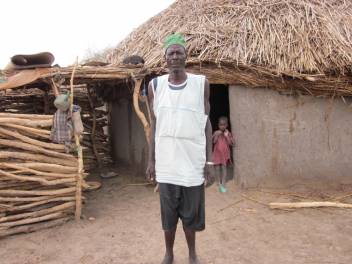 The Haraze Albiar district is in the Western part of Chad, not far from the capital N’Djamena. It is a very rural area, with a lot of small villages scattered everywhere, sometimes with no proper road to access them, just dirt track. It is a very flat landscape with scarce bushes and trees, and during the dry season, everything looks dry, sandy and dead.
The Haraze Albiar district is in the Western part of Chad, not far from the capital N’Djamena. It is a very rural area, with a lot of small villages scattered everywhere, sometimes with no proper road to access them, just dirt track. It is a very flat landscape with scarce bushes and trees, and during the dry season, everything looks dry, sandy and dead.
As soon as the rain falls, everything turns green: The trees and bushes are full of leaves and the sand turns to green grass. There are also a lot of sheep, goats, donkeys and camels.
The villages are very quiet; people live a slow life, far away from the towns, but also far away from schools and health facilities. In some villages, the water borehole only produces water with a bitter taste, which is difficult for people to drink.
Finding out about older people’s nutritional needs
I was there last year to assess the nutritional status of people aged 60 and over. Older people are often forgotten in such crises and the evidence collected helps to raise awareness of the nutrition and health needs of older people in Chad and in the Sahel region. We interviewed over 700 older people and found that over 280 were severely or moderately malnourished.
Our survey was done at the very beginning of the rainy season, when the households have nothing left to eat and are waiting for the next crop to grow. In some villages, they were eating a kind of porridge.
The rains are welcome, but sometimes they are so violent that they flood everything and damage people’s huts. People have to walk in mud for days. In the main town Massaguet, the streets become rivers of mud and dirt; you would not want to walk there without proper boots.
A large part of the population is nomads who have settled down. They have kept their cattle, and they were very proud to share milk with us when we visited their village. We met the nomads outside the village and the chief put large carpets and mats under a big tree so that we were protected from the sun.
Difficult year for farmers
We then started interviewing people under the tree. In one of the villages, we met Hassane Moursal, a traditional dancer and singer who is famous and appears on TV. He is 64, so we included him in the survey.
He lives in a small village with his wife and four children. People ask him to perform at weddings and he earns good money. Wedding season is September to October, so for the rest of year he lives from farming. This year has been difficult for him, and everyone else.
The older people we spoke to told us their diet is composed of a kind of thick porridge made from maize or millet or other cereals. If they can, they add a sauce made from oil, vegetables and sometimes meat or dry fish. They drink large amounts of tea with sugar.
However, the custom in Chad is that everybody eats from the same plate (men and women separately). Food comes in a large round platter; everybody gathers around it and eats from it. This makes it difficult to know how much older people are eating.
The survey also showed that people with poor eyesight were more likely to be malnourished: Could it be because they are slower to reach the food?
Healthcare too expensive
Health and malnutrition are of course closely linked. A lot of older people (more than 80%) reported that they were sick during the month before the survey. The main ailment was pain, including muscular or joint pains, gastric pains, and headaches.
The second cause of illness was malaria. However, almost half of them did not go to the health centre because it is too expensive, as they have to pay for the visit and for the drugs.
The data from this survey is crucial to build evidence on the vulnerability of older people to malnutrition. This is the second nutrition survey of older people we have done, the first being done in a refugee camp, in Dadaab, Kenya. It showed that older people were malnourished, but were not included in any feeding programme.
The same applies to Chad. Our survey shows that older people are malnourished, yet there is no programme to take care of this. Older people in Haraze Albiar do not receive any food aid, even during this big food crisis: Priority is always given to children and pregnant women.
Download the nutritional survey (1.8mb)
Read more about our work supporting older people across Africa and in emergency situations.
